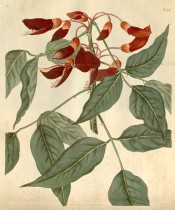Erythrina crista-galli L.
Variable, frost-hardy, open, deciduous tree or woody-based perennial, depending on climate, with spiny branches, leathery leaves composed of 3 leaflets, and terminal racemes, to 60cm long, of deep red flowers, to 6cm long, in summer and autumn. To 4m. [RHSE, Hortus, Hilliers’].
Horticultural & Botanical History
‘This is a much more free and abundant flowering sort than any of this genus with which we are acquainted. Our plant, which was not three feet in height, had near thirty blossoms open at one time. […] It is said to have been introduced from Brazil.’ [LBC no.296/1818].
‘We are indebted to the Honourable William Herbert for the fine specimen of this plant, from which our drawing was taken. This Gentleman remarks “that it must have been an error to imagine this shrub to be a timber tree in Brasil, where it has probably been confounded with some other species. The flowering branches (he observes) die back like those of the Tree-Peony; and although it acquires a woody stem, it does not rise with a continued leader, but the eyes nearest the root break stronger than those higher up the stem”. Indeed it appears to us not altogether certain that this is the Erythrina Crista-galli of Linnaeus. It agrees in most respects with the E. laurifolia of Jacquin, which has always been considered as a synonym of, but which the late Mr. Jonas Dryander suspected to be different from Crista-galli. The figure in Exotic Botany differs from the one here given, in having elliptical obtuse pointed leaves, and strong crooked prickles, but probably belongs to the same species; that in the Botanical Register was done from the same plant as our’s, but in a season when it flowered less favourably.
The flowers grow by threes in the axils of the leaves on the young branches, and also in a terminal raceme of about nine flowers. Sir James E. Smith observes that its monopetalous keel, diadelphous stamens, and form of the stigma, do not properly belong to the genus Erythrina; neither does the vexillum greatly exceed the keel in length.
Native of Brasil. Flowers from March to November. Requires a good deal of water, and Mr. Herbert lays moss about the roots. Introduced in 1771 by Francis Bearsly, Esq.’ [BM t.2161/1820]. This description is of a plant growing in England, probably in a greenhouse. In sub-tropical Australia it grows into a tree. BR f.313/1818. MB p.175/1836.
History at Camden Park
Listed in all published catalogues [T.427/1843]. No longer present in the gardens although a large tree survives in the Old Orchard, now part of the Elizabeth Macarthur Agricultural Institute. A large plant was presented to the Sydney Botanic Garden by William Macarthur on September 15th 1847 [RBGS AB].
Notes
Published Dec 18, 2009 - 04:14 PM | Last updated Jul 21, 2010 - 11:57 AM
| Family | Fabaceae |
|---|---|
| Category | |
| Region of origin | South America |
| Synonyms |
|
| Common Name | Cock?s comb coral tree, Common coral tree |
| Name in the Camden Park Record |
Erythrina cristagalli |
| Confidence level | high |


